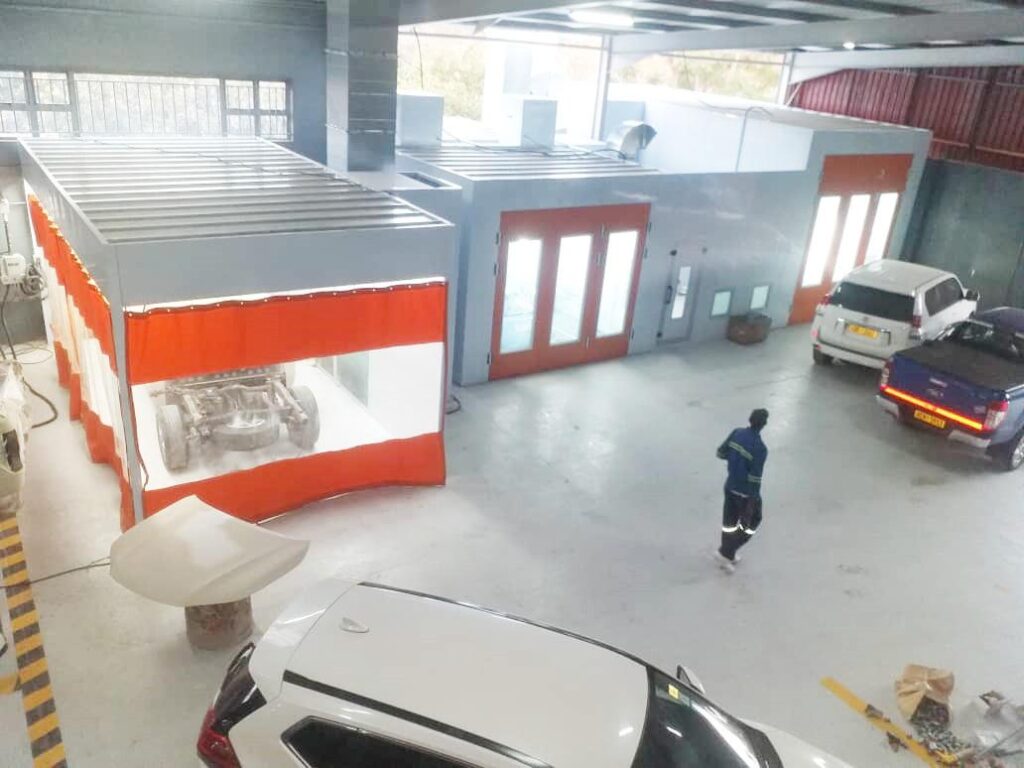Effective Strategies for Thoroughly Cleaning Your Spray Booth:
To achieve a spotless spray booth, begin by eliminating all potential sources of dirt and thoroughly inspecting every interior surface. Ensure that all fans and equipment are powered down before starting the cleaning process. Utilize appropriate solvents, vacuums, or pressure washers to meticulously clean the walls, floors, and filters. Regularly maintaining the exhaust systems is crucial, along with controlling moisture levels and replacing filters every three months to maintain optimal airflow and enhance the quality of your finishes.

Maintaining a clean spray booth is vital for achieving high-quality finishes, reducing the need for rework, and extending the lifespan of your equipment. A meticulously clean booth facilitates better airflow, diminishes the chances of contamination, and assures compliance with necessary safety and environmental standards. By prioritising cleanliness, you can enhance the overall performance of your operations.
Regardless of whether you run a crossdraft booth or an advanced side draft system, implementing consistent cleaning protocols is crucial for optimal booth maintenance and overall performance.
Understanding the Critical Importance of Regular Spray Booth Cleaning
Accumulation of dirt, overspray, and moisture can severely affect the quality of finishes, diminish operational efficiency, and jeopardise the safety of your spray operations. Establishing a routine maintenance schedule ensures that your booth consistently performs at peak efficiency while safeguarding your investment in spray booth technology.
Significant advantages of implementing regular cleaning practices include:
- Enhanced coating consistency across finished products
- Minimised need for expensive reworks due to finish defects
- Prolonged lifespan of filters and duct systems
- Safer working environments for all personnel involved
- Increased energy efficiency and stabilised airflow
Comprehensive Step-by-Step Guide to Effectively Clean Your Spray Booth
Implement Strategies to Minimise Dust Accumulation
Effective booth maintenance begins with proactive measures to prevent dust buildup. It is essential to keep unnecessary equipment, parts, and materials outside the booth at all times. Avoid performing any sanding or preparation of parts within the spray booth; all sanding and bodywork should be completed beforehand to prevent dust from infiltrating the cleaning area.
Incorporating tack coatings or static-reducing wall liners can effectively capture airborne particles, contributing to cleaner interior surfaces and improved operational conditions.
Conduct a Thorough Inspection of the Booth Interior
Prior to initiating the cleaning process, carry out a comprehensive inspection of the booth's interior. Pay particular attention to corners, seams, lighting frames, intake plenum areas, and around exhaust ducts. Look for signs of overspray accumulation, dust buildup, or any indications of corrosion. Mark any areas that require additional attention during the cleaning procedure to ensure nothing is overlooked.
Safely Isolate the Booth and Power Down All Equipment
Before commencing the cleaning process, turn off all power supplies to the booth. This includes deactivating ventilation fans, lighting systems, and any automatic spray arms that may be present. Close all grates, dampers, and air vents to prevent contamination from affecting other areas during the cleaning operation.
Thoroughly Clean All Internal Surfaces of the Booth
Begin the cleaning process from the top and work your way down to avoid resoiling any previously cleaned areas. You may choose to employ one or more of the following effective cleaning methods:
- Industrial vacuum: Utilise this tool to efficiently remove dry dust and debris. Be cautious not to use standard vacuums around any combustible materials for safety purposes.
- Solvent-based mop: Use a spray booth-safe solvent to effectively break down and remove dried paint from walls and floors.
- Pressure washer: This method is recommended for removing heavy overspray from non-electrical surfaces with ease.
- Non-sparking broom and lint-free cloth: These tools are particularly useful in volatile zones where solvents and vapours may be present, ensuring safety during the cleaning process.
Ensure that any solvent used is compatible with the booth’s wall coating to prevent damage. Avoid using generic cleaners that may leave residues or adversely affect surface linings.
Regularly Clean Spray Equipment and Filters for Optimal Performance
It is important to note that overspray and airborne dust do not remain confined to the booth walls; they can also affect your spray equipment. Regularly clean your spray guns, hose connectors, floor grates, intake plenums, and exhaust fans. A blocked exhaust or saturated filter can significantly restrict airflow, leading to increased pressure buildup and diminished spray quality.
If any filters are past their recommended service life, replace them immediately to maintain optimal performance. High-quality replacement filters can be found on our dedicated Spray Booth Filters page.
Proactively Manage Moisture Control Within the Booth
Moisture presents a substantial risk factor in spray booths, particularly when using compressed air systems. Regularly check for condensation on ductwork, walls, and spray lines. It is advisable to install desiccant dryers and moisture separators at critical junctions to effectively manage moisture levels. After cleaning, ensure that the booth is thoroughly dried to prevent the growth of mould and rust.
Essential Cleaning Frequency Checklist for Maximum Efficiency
| Task | Frequency | Recommendation |
|---|---|---|
| Remove dust from floors and walls | Daily | ✔ Recommended |
| Wipe down overspray areas | After each spray job | ✔ Essential |
| Clean spray equipment | Weekly | ✔ Highly advised |
| Clean or inspect exhaust system | Monthly | ✔ Routine check |
| Deep clean and filter replacement | Every 3 months | ✔ Based on usage |



This post brings up such an important aspect of spray booth maintenance that often goes overlooked. I’ve been in the manufacturing industry for a while now, and I can definitely vouch for how a clean spray booth significantly contributes to the quality of finishes. I remember a time when we neglected the regular cleaning schedule, thinking we could cut back on costs and time. The repercussions were swift; contamination became an ongoing issue, and we found ourselves dealing with increased rework and customer complaints. It was a harsh lesson, but it reaffirmed the importance of maintaining cleanliness.
You’ve captured some crucial points about the importance of a clean spray booth. I can definitely relate to the struggles of keeping a workspace spotless, especially in industries where precision is key. In my experience, I’ve found that incorporating a regular cleaning schedule not only saves time but also minimizes the risks of contamination. It’s almost like establishing a routine for self-care—when you maintain your environment, it reflects in the quality of your work.
It’s interesting how much the cleanliness of a spray booth impacts both the final product and the longevity of equipment. I’ve noticed that a regular cleaning schedule not only improves the finish quality but also creates a more pleasant working environment. Implementing a routine, like a check-up every few weeks, has made a noticeable difference in my shop.